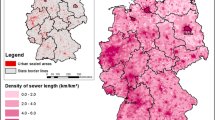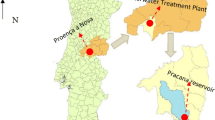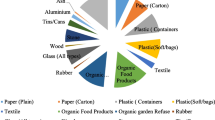Abstract
Due to the high waste deposition in superficial water, studies are necessary to emphasize the importance to monitor and apply tools, such as mathematical modelling. In this study, we used the classic Streeter and Phelps model to simulate the travel time necessary to depurate organic matter in the Tatu stream, at Limeira, São Paulo, Brazil, and to simulate the point-to-point depuration of organic matter in comparison to point-to-point empirical analysis. According to the simulations, organic matter would be established to 10 mg/L \(\hbox {O}_2\) in few hours of time course of water without discharges in the stream, having the watercourse self-decay capacity. In addition, the analysis indicates that possible launches are being carried out along the stream, because, at the collection points, the obtained results presented higher biochemical oxygen demand than the expected for organic matter depuration, which denote discharges occurrences. Thus, this study emphasizes the relevance of monitoring actions and puts the model as a suitable tool to identify discharge sources in water.

Source: Adapted from Google \(\hbox {Earth}^{{\textregistered }}\)








Similar content being viewed by others
References
Ali I, Asim M, Khan T (2012) Low cost adsorbents for the removal of organic pollutants from wastewater. J Environ Manag 170–183
Apha (2012) Standard methods for the examination of water and wastewater. Apha, Washington
Brazil (2005) CONAMA \(\text{n}^o 357\), Ministry of the Environment, Resolution of March 17, 2005. http://www.mma.gov.br/port/conama/res/res05/res35705.pdf. Accessed 14 Dec 2016
Churchill MA, Elmore HL, Buckingham RA (1962) The prediction of stream reaeration rates. Am Soc Civ Eng J 88:1–46
Duncan JS, Savage N, Street A (2014) Competition for water. In: Nanotechnology applications for clear water, 2nd edn. Solutions for improving water quality, vol 35. Elsevier, pp 529–555
Fan FM, Fleischmann AS, Collischonn W, Ames DP, Rigo D (2015) Large-scale analytical water quality model coupled with GIS for simulation of point sourced pollutant discharges. Environ Model Softw 64:58–71
Gray NF (1992) Biology of wastewater treatment. Oxford University Press, New York
Jiang T (2017) Characteristics of dissolved organic matter (DOM) and relationship with dissolved mercury in Xiaoqing River-Laizhou Bay estuary, Bohai Sea, China. Environ Pollut. https://doi.org/10.1016/j.envpol.2016.12.006
MMA-Ministério do Meio Ambiente (2014) Conjuntura dos Recursos Hídricos, Encarte especial sobre a crise hídrica, Agência Nacional das Águas, Brasil. http://conjuntura.ana.gov.br/docs/crisehidrica.pdf. Accessed 13 Nov 2016
Munster U, De Haan H (1998) The role of microbial extracellular enzymes in the transformation of dissolved organic matter in humic waters. Aquat Humic Subst Ecol Stud 133:199–257
Odebrecht (2015) Processos de tratamento de esgoto de Limeira. http://www.odebrechtambiental.com/limeira/agua-e-esgoto/seu-esgoto/seu-esgoto-processos-de-tratamento/. Accessed 10 Oct 2016
Owen DM, Amy GL, Chowdhury ZK, Paode R, McCoy G, Viscosil K (1995) NOM characterization and treatability. J Am Water Works Assoc 87(1):4663
Owens M, Edwards RW, Gibbs JW (1964) Some reaeration studies in streams. Int J Air Water Pollut 8:469–486
Regattieri SMCB (2007) Geoquímica de águas e sedimentos da bacia do ribeirão Tatu, Limeira-SP, dissertation, Geo Sciences Institute, State University of Campinas-UNICAMP, Brazil
Scheili A, Delpla I, Sadiq R, Rodriguez MJ (2016) Impact of raw water quality and climate factors on the variability of drinking water quality in small systems. Water Resour Manag 30:2703–2718
Sibil R, Berkun M, Bekiroglu S (2014) The comparison of different mathematical methods to determine the BOD parameters, a new developed method and impacts of these parameters variations on the design of WWTPs. Appl Math Model 38:641–658
Snis (2017) National Sanitation Information System, Ministry of cities, Brazil. http://www.snis.gov.br/. Accessed 30 Jan 2017
Streeter HW, Phelps EB (1925) A study of the pollution and natural purification of the Ohio river, United States Public Health Service. Public Health Bull 1:146
Teixeira MR, Rosa SM, Souza V (2011) Natural organic matter and disinfection by-products formation potential in water treatment. Water Resour Manag 25:3005–3015
Tundisi JG, Tundisi-Matsumura T (2008) Limnologia. Oficina de Textos, São Paulo
Von Sperling M (2008) Estudos e modelagem da qualidade da água de rios, DESA, Ed. UFGM, Minas Gerais, cap. 1, 2, 6, 7 e 8
Von Sperling M (2009) Introdução à qualidade das águas e ao tratamento de esgoto, Princípios do tratamento biológico de águas residuárias. Ed. UFMG, Minas Gerais, pp 19–49, cap. 1.3–1.7
Wang Q, Li S, Jia P, Qi C, Ding F (2013) A review of surface water quality models, review article. Sci World J 2013:7
Wetzel RG, Likens GE (1991) Limnological analyses. Springer, New York
Yang YS, Wang L (2010) A review of modelling tools for implementation of the eu water framework directive in handling diffuse water pollution. Water Resour Manag 24:1819–1843
Acknowledgements
Funding was provided by Capes.
Author information
Authors and Affiliations
Corresponding author
Additional information
Communicated by Jose Alberto Cuminato.
Rights and permissions
About this article
Cite this article
de Cássia da Cunha, A., Coneglian, C.M.R. & Poletti, E.C.C. Sewage discharge and water self-decay: Streeter and Phelps model application. Comp. Appl. Math. 37, 3514–3524 (2018). https://doi.org/10.1007/s40314-017-0526-x
Received:
Accepted:
Published:
Issue Date:
DOI: https://doi.org/10.1007/s40314-017-0526-x
Keywords
- Superficial water quality
- Dissolved oxygen (DO)
- Water management
- Water reoxygenation
- Water deoxygenation




